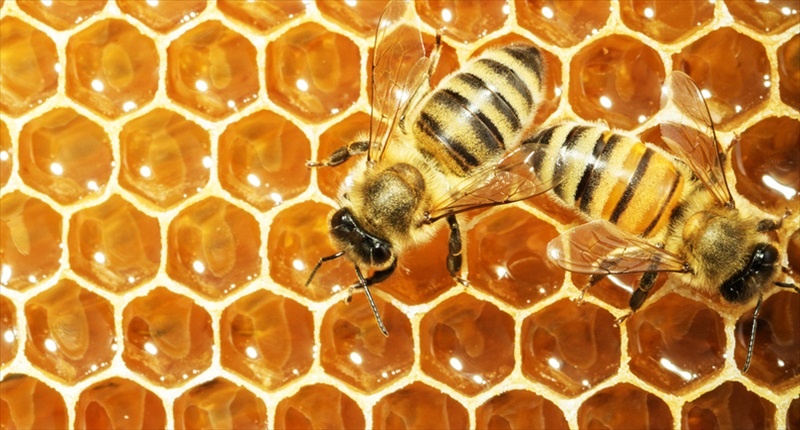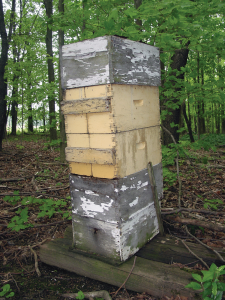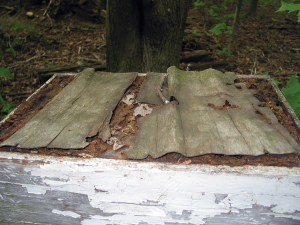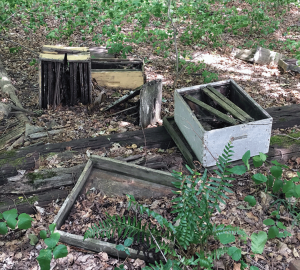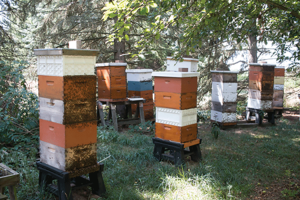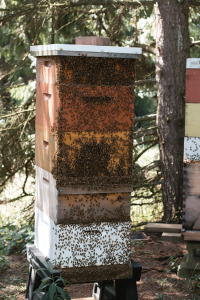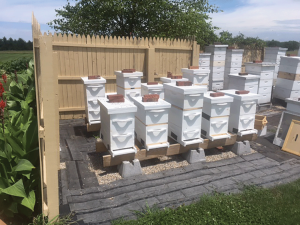by- James Tew
 The Life and Death of a Survivor Colony.
The Life and Death of a Survivor Colony.
Removing Honey From Big, Hot Colonies.
Odds and Ends – When Water Foragers Abandon An Established Water Source
Top Bar Plans
The life and death of a survivor colony (1980-2016)
I’ll bet that not a single one of you will remember a short interactive series that I wrote in 2005. Indeed, many of you were not even beekeepers at that time. The article that started the discussion was entitled, “An Unclear Case of Colony Survival – Lonely, Unloved, but Apparently Prosperous (December, 2005).” This entire article is available at the URL presented in the footnote below1. Now before I go any farther, this review describes a colony that was started during the early 1980s and lived – without much beekeeper intervention – far beyond all other colonies in that yard. This is not the story of a typical beehive.
This is a summary of what happened with this unique colony, and how it ended. During 1979 and 1980, during my very first years at The Ohio State University, I literally stumbled into an international grant project that ultimately went on for several years. Agricultural officials in Myanmar (then Burma) had been introducing honey bees (Apis mellifera) into selected parts of that county and wanted to send military combat veteran officers to Ohio State to be taught advanced beekeeping and honey harvesting techniques. Subsequently, officers returned to Myanmar (Burma) to be teachers themselves.
Today, there would need to be serious discussions about the various environmental impacts on the Burmese ecosystem, but at that time, the administrative decision had already been made and honey bees were already in the country. Until then, there had been no (known) honey bees in Burma. Honey production was the primary objective of the project.
During the same timeframe, students from the world over began to participate in additional training programs being offered at the time. These international students frequently introduced other beekeepers to concepts and hive designs being used in their respective countries.
As a generalized teaching tool, my small staff and I set up an “international” hive yard in a remote, difficult to reach by vehicle area. As best we could, we duplicated some of these international hive designs. The yard had top bar hives from Kenya and Uganda, Botswana tree hives, African long hives, compressed straw hives, and for good measure, we put an eight-frame colony and a skep or two.
As quickly as the grant funding began, it just as quickly began to wane – primarily due to the arrival of Africanized bees and parasitic mites in the U.S. After about eight years, the training endeavor flickered out. Shortly thereafter, we closed out the international hive yard and went on with our lives – except for the single colony in eight-frame equipment. It was left in that yard until it was needed. Ironically, it sat there in that isolated yard – waiting to be needed – from 1987 or so, until 2005. The details to this point are in the archived article.
In 2005, I remembered the lone hive and using four-wheel equipment, I made the trip to the isolated location. The hive that had been unloved for 18 years was there, and it was – packed with bees. The condition of the equipment was interesting. Both the flat transportation top and the traditional bottom had (mostly) rotted away. Approximately one-third of the outer cover was actually propolis. All else was solid.
This is where you come in
At that time, I asked BC readers what to do with this colony. Should I jump in and upgrade the equipment, check for diseases, or just leave it where it is. As I recall, something like 85% of you said don’t touch it. The colony did not need me. I took your advice.
In 2010, Ohio State, Wooster Campus suffered a disastrous tornado. The losses to the bee program were huge. Approximately a month after that storm, I remembered that I had not visited the Survivor Colony in five years. I hoped that the tornado spared the persistent colony. It had not. The hive had been laying facedown for about a month. Without much thought, I stood it back up. Years ago, the outer cover had blown off, so I put on this original outer cover that had been laying near the hive all these years. That was all I did. The bees were still alive, but the hive was a muddy mess. I then told you readers what I had done to restore the colony and its hive. Most of your responses were that I should have let it die. I just could not do that.
After retiring from Ohio State, I relinquished my responsibility to the OSU bees. Six years have passed since the tornado, and last month, I decided to visit the long-lived colony. It was not good. Sometime during the past year or two, something had happened to destroy the colony. Equipment was scattered, and all was in disarray. It appeared to have been kicked over.
Ironically, the combs in that colony had never been exposed to any miticides. The colony was never treated – for anything. It was never requeened. There was never any swarm control. It was never prepared for Winter. It always had done its own thing. Now you and I both know that the bee cluster had probably come and gone several times during the years, but even so, it (apparently) had bees in it most of those years.
Epitaph
Except for me setting it up and replacing a cover that had blown off years ago, the colony was never touched. For about 34 years, bees did their own thing without beekeeper intervention. Through the years, I enjoyed my interaction with this unique colony. But all things must end2.
More photos
More photos of a long hive, TBH, and other hive designs are stored at the following URL. Also, a few more photos of the fallen survivor hive are presented:
https://onetewbee.smugmug.com/September-2016-Survivor-Colony/n-96fpZG/
Shorter URL for hand copying: http://tinyurl.com/Survivor-Hive
Removing honey from populous, hot, tall colonies
Right out of the gate, I need to ask, “Why would anyone open, big, hot, tall colonies?” Because you need to get that honey off in order to perform the late season mite treatments. Possibly, another reason is that you may not want the bees to blend Spring honey with Fall honey. Who knows – maybe you have other reasons. Whatever the reason, this is a task for an experienced beekeeper with a good back, or for a beekeeper with good beekeeper friends who can help with the project.
An aside before I begin
In past articles, I have had pity-party after pity-party in this monthly column about various maladies and disasters that have befallen my bees. I think that learning from errors and bad luck is sensible – even logical. What else can you do with problems that are difficult to correct? Colonies died in the Winter, colonies produced high swarms, mites were running the show in my yard, and some of my queens were ugly. But . . .
Right now, my colonies are simply spectacular. Everything is full and bees are bearded out front. I must say that I have been doing this bee thing most of my adult life, and yet, I find myself more than a bit cautious about being in my apiary without proper protective clothing – especially when the weather is hot and dry. These oversized colonies can be a short fused bomb if mishandled.
These colonies are at full population. It is now mid August. Nothing much is in bloom, and nearly all of these bees are unemployed. If you open these units, they have little to do but come after you. These colonies are not the pliable kittens of the early Spring type colonies.
I want to get these full deeps off in order to extract and to use oxalic acid to knock the mites back. These colonies appear to be able to withstand anything, but please know that the mite population is building up and can take these big hives down in just a few weeks.
Choose the day
In a perfect world, I would choose mid to late afternoon for the removal task. These bees will be upset, and I want to try to maintain control on how far and wide they make their ire known. Though it would only make the honey removal process worse, it could be done during a moderate rain shower. I could do the removal job at night, but that is really an adventure. In all things, I must be concerned for my neighbors.
For you lucky bee people whose colonies are far from the madding crowd, you can do the removal task anytime you like.
Smokers blazing and bee suits subsidized with duck tape
Do any of you remember my admonishments to only lightly use smoke? Forget that advice now and dependably fire those big canister smokers. Any of you remember me telling you to be comfortable and don’t worry about the gloves. Bad advice for this situation. Suit up and glove up. On hot days, don’t bother with a sweatband. It won’t help and only makes your head hotter.
If you can get along without your glasses, leave them off. If not, use a glasses strap and put a washcloth within you veil. You will have sweat running off you and onto your glasses. The cloth is not perfect, but it will help some. In some way, keep the bees from getting up your pant legs. Put a piece of tape over the zipper that is at your neck level.
Everything else ready?
Hive tools? You should probably have more than one. Do you have a leaf blower? Top it off with fuel and have it warmed up so it will start as easily as possible. Don’t have one? See if you can borrow one. They can be rented. Bee supply companies will happily sell you one. These bees will be seriously unhappy if you start trying to brush frames and keep the colony opened a long time. Using some kind of bee escape will only make you and the bees miserable twice.
Using a blower is not perfect. It’s noisy and smelly, but use it – and use it quickly and be gone. If you seriously overheat yourself, put the blower nozzle in your bee suit pocket and run the throttle up to about one-quarter. You will look like the Pillsbury® Doughboy, but you will blow some heat out of your bee suit. If you are truly overheated, I do not need to tell you to take a break.
If you take off more than a few supers, you will need a wagon or a cart. While running the blower, some kind of table or a set of sawhorses would be very useful. Setting honey supers on end will while using the blower will make both your life and your bees lives just a bit better.
Okay, go get them
Upon entering the yard, vigorously smoke all the colonies but don’t choke them. Choose your starting point and work quickly and steadily. Don’t kill yourself. It will be hot in that suit. Upon getting most of the bees out, use outer covers to cover the top and another to serve as a bottom – almost like a tray beneath the stack as you continue to add to it.
It’s more than a bit difficult, but try to watch for brood patches in honey supers. The colonies’ queen could be there. Don’t spend a lot of time trying to gouge out frames that are jammed in with honey to search for the queen. After blowing the bees out and before moving to the next colony, check around for any cluster of bees on the ground or wherever. They could be surrounding the queen.
Keep the smoke going on the ones not opened yet. This is to hold down robbing behavior as much as possible and to disorient organized defenders. After removing honey, if you have extra supers or deeps, you might consider putting them on in order to give the displaced bees a clustering space. Otherwise, they will really beard on the outside.
The crop is off and you are one tired beekeeper
If you had the equipment, the stacks will be covered – top and bottom. If at all possible, until it can be extracted, store this unextracted honey is a bee-tight location. I expect that you will leave more than a few bees in the removed supers. You simply cannot reasonably get them all. Consequently, in your bee-tight room/screened porch, you will have some bees. If possible, turn off lights and open doors long enough for bees to leave.
Though better than nothing, supers stored on screened back porches will attract bee foragers. The smell of honey will drive them nutty.
If you are in Small Hive Beetle areas, those isolated honey supers cannot sit very long before the risk of beetle invasion occurs. Obviously, you must move expeditiously to get the crop extracted and the wet supers back on the bees.
Back in the yard, everything should be closed up. There will be bees everywhere. It should be late in the day by now. Not surprisingly, quite a number of these bees will not be yours. All those good aromas of honey being blown around your apiary will bring in neighboring bees, too. During nighttime, I would hope the bees would quiet a bit and things would begin to calm.
At the end, you will be hot and sweaty and will reek of bee smoke, but the job is done. Now “Little Red Hen” beekeeper, who is going to extract that crop? Maybe we will consider that topic later.
Odds and Ends
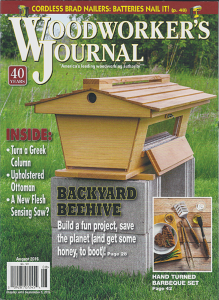 High End Top Bar Construction Plans
High End Top Bar Construction Plans
For those beekeepers who are both accomplished woodworkers and top bar hive beekeepers, the Woodworker’s Journal (August, 2016) had a front page layout of a stylishly designed TBH. Within the magazine, complete plans and photos are presented. The design is clean and crisp and is a bit complex to construct. (Contact Bee Culture for a photocopy of the plans.)
Bees are finicky about their water source
For several years, I have been using a blue kid’s wading pool to provide water for my bees. Having read that water foragers could more easily find water that was less than pristine, I made no particular effort to keep pure water in it.
The pool finally developed a small crack that allowed the water to leak out. I purchased another pool, filled it with beautiful water, and put the same floats in place. After only one day of being empty, the foragers nearly completely abandoned the source. Same location, same type of container, same floats – but different water – resulted in 99% of the foragers abandoning the source. Now, all those foragers are somewhere else in my neighborhood, and I don’t even want to think where that might be. Could I speculate that bees are not particularly crazy about pristine water or that changing the aroma and flavor of the water confused the foragers?
Senior Citizens update
I continue to get responses from Senior Citizen beekeepers with photos and procedures. Also, I frequently get water source ideas and hive stand designs. I dutifully store them all. At some point, I will do something with these responses, but just now, they are steadily coming in.
I will have more designs and concepts for seniors (or anyone else) in future articles. Until, I consider more of their ideas, consider this concept – seven-frame equipment with greatly enlarged handles.
Well, I’m out of space. I look forward to your continued responses and suggestions. We’re all in this together.
 1http://ww.mediafire.com/download/49213oltc3bd93o/BC.2005.12.pdf
1http://ww.mediafire.com/download/49213oltc3bd93o/BC.2005.12.pdf
Shorten URL for hand copy: http://tinyurl.com/Survivor-Colony
2And yet, things will go on. The yard is a remote, unused area. Once again, I did not touch anything. Now just for the curiosity of it, I would like to see how long it takes abandoned bee equipment to rot away. Hmmmm, I wonder if I have enough time to make this observation.
Dr. James E. Tew, State Specialist, Beekeeping, The Alabama Cooperative Extension System, Auburn University; Emeritus Faculty, The Ohio State University. Tewbee2@gmail.com; http://www.onetew.com; One Tew Bee RSS Feed ( http://www.onetew.com/feed/ ); http://www.facebook.com/tewbee2; @onetewbee Youtube: https://www.youtube.com/user/onetewbee/videos






